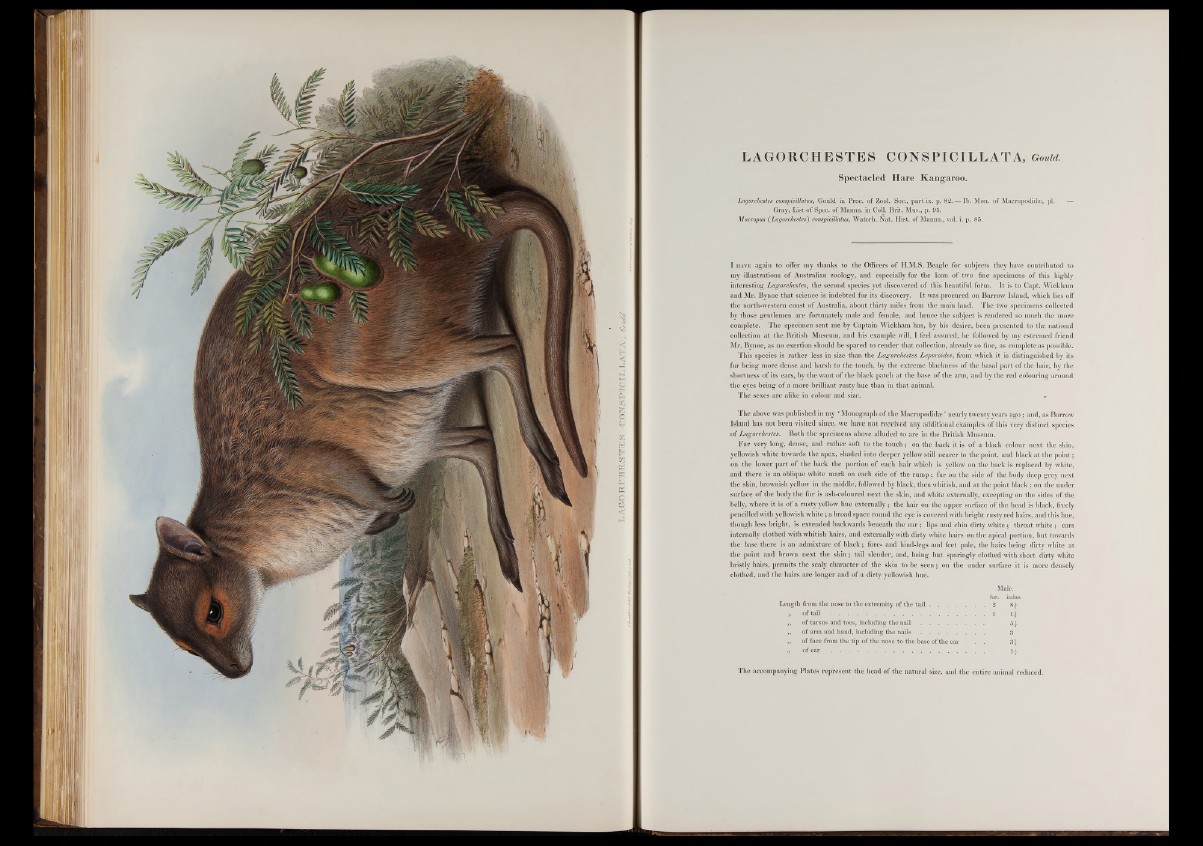
LAGORCHESTES CONSPICILLATA, Gould.
Spectacled Hare Kangaroo.
Lagorchestes conspicillatus, Gould in Proc. of Zool. Soc., part ix. p. 82. — lb. Mon. of Macropodidse, pi.
Gray, List of Spec, of Mamm. in Coll. Brit. Mus., p. 95.
Macropus ( Lagorchestes) conspicillatus, Waterh. Nat. Hist, of Mamm., vol. i. p. 85.
I h a v e again to offer my thanks to the Officers of H.M.S. Beagle for subjects they have contributed to
my illustrations of Australian zoology, and especially for the loan of two fine specimens of this highly
interesting Lagorchestes, the second species yet discovered of this beautiful form. It is to Capt. Wickham
and Mr. Bynoe that science is indebted for its discovery. It was procured on Barrow Island, which lies off
the north-western coast of Australia, about thirty miles from the main land. The two specimens collected
by those gentlemen are fortunately male and female, and hence the subject is rendered so much the more
complete. The specimen sent me by Captain Wickham has, by his desire, been presented to the national
collection at the British Museum, and. his example will, I feel assured, be followed by my esteemed friend
Mr. Bynoe, as no exertion should be spared to reuder that collection, already so fine, as complete as possible.
This species is rather less in size than the Lagorchestes Leporoides, from which it is distinguished by its
fur being more dense and harsh to the touch, by the extreme blackness of the basal part of the hair, by the
shortness of its ears, by the want of the black patch at the base of the arm, and by the red colouring around
the eyes being of a more brilliant rusty hue than in that animal.
The sexes are alike in colour and size.
The above was published in my ‘ Monograph of the Macropodidse ’ nearly twenty years ago; and, as Barrow
Island has not been visited since, we have not received any additional examples of this very distinct species
of Lagorchestes. Both the specimens above alluded to are in the British Museum.
Fur very long, dense, and rather soft to the touch; on the back it is of a black colour next the skin,
yellowish white towards the apex, shaded into deeper yellow still nearer to the point, and black at the point;
on the lower part of the back the portion of each hair which is yellow on the back is replaced by white,
and there is an oblique white mark on each side of the rump; fur on the side of the body deep grey next
the skin, brownish yellow in the middle, followed by black, then whitish, and at the point black; on the under
surface of the body the fur is ash-coloured next the skin, and white externally, excepting on the sides of the
belly, where it is of a rusty yellow hue externally; the hair on the upper surface of the head is black, freely
pencilled with yellowish white; a broad space round the eye is covered with bright rusty red hairs, and this hue,
though less bright, is extended backwards beneath the ea r; lips and chin dirty white; throat white; ears
internally clothed with whitish hairs, and externally with dirty white hairs on the apical portion, but towards
the base there is an admixture of black; fore- and hind-legs and feet pale, the hairs being dirty white at
the point and brown next the skin; tail slender, and, being but sparingly clothed with short dirty white
bristly hairs, permits the scaly character of the skin to be seen; on the under surface it is more densely
clothed, and the hairs are longer and of a dirty yellowish hue.
Male.
feet, inches.
Length from the nose to the extremity of the tail . . . . . . . 2 8£
„ of tail . . . ...................................... ...............................i i£
,, of tarsus and toes, including the n a i l ...................................... 5±
„ of arm and hand, including the n a i l s ...................................... 3
,, of face from the tip of the nose to the base of the ear . . 3£
,, of ear ............................................................... jj.
The accompanying Plates represent the head of the natural size, and the entire animal reduced.